Copy of Federal Transgender Guidelines (White House) [download]
Here is a full copy of the US Departmentof Justice and US Department of Education guidance for transgender students:
(dl link)
This guidance was released Friday May 13th, 2016. Our local public school received it on that date, and today a meeting was held briefing teachers.

Screenshot of the document
The aforementioned document provides the basic guidelines but lacks many concrete examples. Thankfully, for parents seeking more information-or for students that attend public school or state colleges-there is some additional information below related to bathrooms and student privacy. Specifically, Examples of Policies and Emerging Practices for Supporting Transgender Students available for download here:
(dl link)
Regarding bathroom usage and privacy for non-transgender students, here is the most relevant portion of the Examples of Policies and Emerging Practices for Supporting Transgender Students:
[START QUOTE, w/links & info added in italics]
8. How do schools protect the privacy rights of all students in restrooms or locker rooms?
Many students seek additional privacy in school restrooms and locker rooms. Some schools have provided students increased privacy by making adjustments to sex-segregated facilities or providing all students with access to alternative facilities.
- The Washington State Guidelines (link 1) (link 2) provide that any student who wants increased privacy should be provided access to an alternative restroom or changing area. The guidelines explain: “This allows students who may feel uncomfortable sharing the facility with the transgender student(s) the option to make use of a separate restroom and have their concerns addressed without stigmatizing any individual student.”
- The guidelines also state that any student who has a need or desire for increased privacy should be provided access to an alternative restroom, such as a staff or health office restroom, but that no student should be required to use an alternative restroom just because they are transgender or gender nonconforming. –Rights of Transgender People in Washington State
- The NYSED Guidance gives an example of accommodating all students’ interest in privacy: “In one high school, a transgender female student was given access to the female changing facility, but the student was uncomfortable using the female changing facility with other female students because there were no private changing areas within the facility. The principal examined the changing facility and determined that curtains could easily be put up along one side of a row of benches near the group lockers, providing private changing areas for any students who wished to use them. After the school put up the curtains, the student was comfortable using the changing facility.”
- Atherton High School, in Jefferson County, Kentucky, issued a policy that offers examples of accommodations to address any student’s request for increased privacy: “use of a private area within the public area of the locker room facility (e.g. nearby restroom stall with a door or an area separated by a curtain); use of a nearby private area (e.g. nearby restroom); or a separate changing schedule.” The DCPS Guidance recommends talking to students to come up with an acceptable solution: “Ultimately, if a student expresses discomfort to any member of the school staff, that staff member should review these options with the student and ask the student permission to engage the school LGBTQ liaison or another designated ally in the building.”